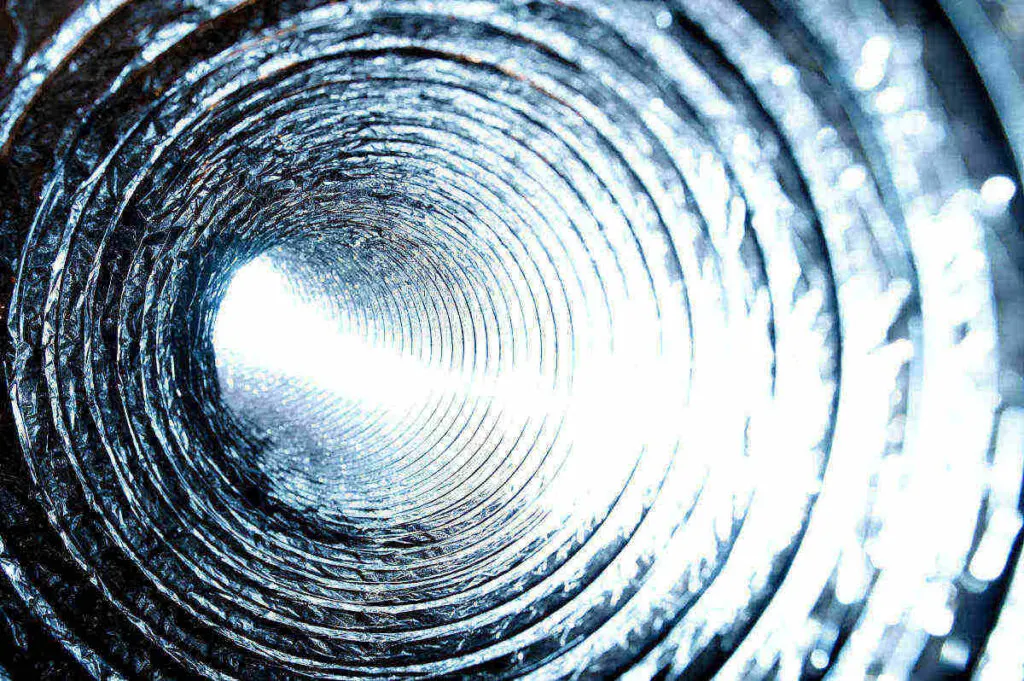Flexi duct is a versatile and effective ducting that is appropriate for use in many ventilation and exhaust systems, and it comes in many variations, each with its own attributes. It is well known and commonly seen, but it helps to have a more precise understanding of where flexi duct can be used.
Table Summary of Where Flexi Duct Can Be Used:
| Crawl Space | Yes | Applicable for crawl spaces, but must be protected from animals and elements. |
| Attic | Yes | Applicable for attics, but not if the attic is used as a living space. |
| Return Air | Yes | Applicable for return air application, below temperature and pressure thresholds. |
| Heating | Conditionally | Applicable if air temperatures do not exceed 121 °C (250 °F). |
| Dryers | No | Not applicable as per the IRC regulations. |
| Range Hood | No | Not Applicable as per the IRC regulations. |
| Bathroom Fan | Yes | Applicable if insulated flex duct is used. |
The answer to the question, “where can flexi duct be used?” is a broad one, but it is safe to say that this ducting can be used for a wide variety of applications. The table above offers a summary, but let’s look more closely at where flexi duct can be used.
Can Flex Duct Be Used in Crawl Space?

Ducts and exhaust systems often run through crawl spaces as it is easier and less intrusive to use this pre-existing space for ventilation and exhaust systems.
Flex duct can be used in crawl spaces and is often used for this application because it is easier to install than rigid ducting.
Using flex duct in a crawl space is preferable over a rigid duct when the crawl space is very narrow, difficult to work in, or if the duct has to be used in tight bends, corners, and through tight openings in the structure of the building.
While the flexibility of flex duct is what makes it an excellent and easy-to-install option for use in crawl spaces, flex duct is far less durable than rigid duct and is susceptible to damage from weather, flooding, animals, and mechanical distress (impact, squeezing, etc.).
For these reasons, flex duct requires more maintenance than hard duct, which can be an inconvenience if used in a crawl space, as these areas are often very difficult to gain access to and to work in and can be a very unpleasant environment to spend time in.
When flex duct is used in a crawl space, the duct system must not terminate within the crawl space, as this contravenes section M1501.1 of the International Residential Code (IRC), which prohibits air from being exhausted into a crawl space.
Will Mice Chew Through Flex Duct?

A common problem with fexi duct systems is rodent damage. Mice and other rodents are known to often chew through flexi duct, especially any ducting that uses any fiberglass material.
Rodents tend to use these materials for nesting, and flexi duct is not rigid nor tough enough to prevent rodents such as mice from chewing through it to gather nesting materials.
Rodents tend to use travel routes through their environment, and a flexi duct system that interferes with these routes is likely to be chewed through in order for the mice to traverse their usual “highways”.
This problem is very difficult to resolve, but the best way to keep mice from chewing through flexi duct is to eliminate the rodent problem before installing the ducts.
If a rodent problem arises, it is best to employ the services of professional exterminators to resolve the problem quickly and effectively to protect the flexi duct system.
Flexi Duct Use in the Attic
Flex duct can be used in an attic. In fact, flex duct is one of the most commonly used ducting in attics.
This type of ducting material is used so frequently in attics because it is far easier to install than rigid ducts, and it is likely to take up less space in this area of a house.
However, there are some circumstances when using a flexi duct in an attic may not be ideal. If the attic has been converted to be a living space, flexi duct is not ideal because it easily collects dust while being difficult to clean, the air flowing through the system is noisy as it is not well insulated, and flexi duct does not look as appealing as hard duct.
If the attic is used as a storage space, or if it is unused, flexi duct is ideal because it is simple to install, it is inexpensive, and if the space is used for storage, it may even be re-routed to make more space for storing larger items.
When using flexi duct in an attic, it is important that the ducts do not terminate within the attic, as this too contravenes section M5101.1 of the IRC.
Can You Use Flex Duct for Return Air?
Flex duct can be used for return air, but there are some conditions for its use in this application.
This type of ducting must adhere to strict temperature regulations and is only rated for certain pressures. For flex duct to be used for return air, the air must not be hotter than the manufacturers’ specifications and the stated regulations by the IRC.
Pressure must also be considered, and flex duct can only be used for return air if the air is pumped through it at lower pressures than the regulated maximum air pressure according to the diameter of the duct.
This is due to the fact that flex duct is not as durable as rigid duct and can not withstand the same pressure levels.
Flex duct may have to be insulated for use as a return duct, but that is up to the discretion and requirements of the individual installing the duct system.
Can Flexible Duct Be Used for Heating?

Flexible duct is very versatile and can be used for many ventilation purposes. However, there are restrictions regarding its use based on regulations and the limitations of the materials that are used to make flex duct.
According to the limitations of flex duct material, this ducting cannot be used in any system with air temperatures that exceed 121 °C (250 °F). Temperatures above this limit will severely damage flex duct, compromise its integrity, and may even cause fires.
Flexible duct systems should be kept away from heat sources, and if used for hot air, should not be installed near any flammable surfaces and should not pass through any walls or floors.
When used for heating, flex ducts should adhere to manufacturer regulations that stipulate the clearance between ducts that are used for heating, both from other ducts and from other materials and surfaces within a home or building.
Are You Allowed to Use Flexi Duct for Dryers?
Flexi duct is cost-effective and used for many various types of ventilation and exhaust systems, but it is better suited for some systems than others.
An example is a dryer system. Flexi duct cannot be used for dryers, as it does not comply with the IRC regulations for dryer ducts.
International Residential Code M502.4.1 – Material and size: Exhaust ducts shall have a smooth interior finish and shall be constructed of metal not less than 0.0157 inch (0.350mm) in thickness (No. 28 gauge). The duct shall be 4 inches (102mm) nominal in diameter.
The above IRC section states that the ventilation ducts for dryers must be made from specific metal (like galvanized steel), and they must have smooth interior walls. This prohibits the use of flexible duct, as it is not made from metal, and the collapsable and flexible design of the ducting means that it does not have a smooth interior surface.
There are other regulations that exclude flexi duct from being used for dryer ventilation systems, but this is the first on the list and immediately disqualifies flexi duct from this application.
So, why is flexi duct unusable for dryer ventilation?
One of the primary reasons is that flexi duct is difficult to clean due to its design. This is a problem as dryer ducts can collect lint, dirt, and dust, which may cause a fire hazard. This is another IRC regulation pertaining to dryer ventilation exhaust systems: they must be cleanable.
Due to these IRC regulations, you are not allowed to use flexi duct for dryers, and these strict cleaning requirements are also one of the main reasons why you can never vent a bathroom fan and dryer together.
Related article: Can a Dryer be Vented Through a Soffit
Can Flex Duct Be Used for a Range Hood?

Flex duct can not be used for a range hood, as it does not meet the IRC regulations for this type of ventilation.
IRC regulations section M1503 – M1503.1; M1503.2; M1503.3; M1503.4; and M1503.6.2 all prohibit the use of flex duct for a range hood.
A range hood duct must be made from specific metals of a certain gauge, have smooth interior walls, must be air-tight, be equipped with a backdraft damper, and be independent of all other ventilation systems.
As flex duct can not meet these regulations, it should not be used for this application.
Here is a comprehensive resource for why flex duct cannot be used for range hood ventilation and what should be used instead.
Using Flexi Duct for Bathroom Fan
Using flexi duct for a bathroom fan ventilation and exhaust system is a common application of flexi duct, as it is very simple to install and has a long lifespan.
This type of ducting is allowed by IRC regulation for bathroom fan duct applications, which means that they are safe to use and will be effective for use in this type of system.
Flexi duct can be well insulated and well protected from humidity and moisture, which makes it ideal for use in a bathroom fan duct.
The design of flexi duct means that it can be installed easily into confined spaces, and maintenance and necessary repairs can be performed very easily as well. These attributes are complimentary for bathroom fan vent systems.
The flexibility of this type of ducting means that it can bend and conform to corners and be installed around potential obstacles that would hinder the installation and function of rigid duct, especially when used in small areas such as the bathroom.
This article is a great in-depth resource for using flex duct for a bathroom fan ventilation and exhaust system and covers which type of flexi duct is best suited for this purpose.
When deciding if flexi duct is the best option for venting your bathroom fan, consider where the fan should vent to, and ensure that using flexi duct will allow this to be done.
Does Flex Duct Reduce Airflow?
Flex duct has many advantages, but one disadvantage of using this type of ducting is that it does reduce airflow.
Without a smooth interior, and the ability to maintain constant high pressure within the system, flex duct is unable to maintain maximum airflow throughout a system.
These negative effects on airflow can be significantly reduced by using appropriately short lengths of flex duct, especially for corners, and by keeping the duct as straight as possible.
If corners must be used in the ventilation system, the flex duct that is used should be utilized to make the corner as gentle as possible sharp corners significantly hinder airflow.
Flex duct does reduce airflow, but in most modern systems, it is not enough to significantly reduce the effectiveness of the system.
Sources
https://flexibleduct.org/images/ADC~IR5E.pdf
https://codes.iccsafe.org/content/IRC2018/chapter-15-exhaust-systems
https://codes.iccsafe.org/content/IRC2015/chapter-16-duct-systems
https://hvac-talk.com/vbb/threads/182554-Tight-Duct-Retrofit-will-the-MICE-eat-Flexiduct
https://www.diychatroom.com/threads/using-flex-duct-for-return.123365/
